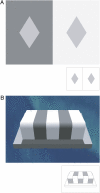Understanding vision in wholly empirical terms
- PMID: 21383192
- PMCID: PMC3176612
- DOI: 10.1073/pnas.1012178108
Understanding vision in wholly empirical terms
Abstract
This article considers visual perception, the nature of the information on which perceptions seem to be based, and the implications of a wholly empirical concept of perception and sensory processing for vision science. Evidence from studies of lightness, brightness, color, form, and motion all indicate that, because the visual system cannot access the physical world by means of retinal light patterns as such, what we see cannot and does not represent the actual properties of objects or images. The phenomenology of visual perceptions can be explained, however, in terms of empirical associations that link images whose meanings are inherently undetermined to their behavioral significance. Vision in these terms requires fundamentally different concepts of what we see, why, and how the visual system operates.
Conflict of interest statement
The authors declare no conflict of interest.
Figures






References
-
- Palmer S. Vision Science: From Photons to Phenomenology. Cambridge, MA: MIT Press; 1999.
-
- Hubel DH, Wiesel TN. Brain and Visual Perception. New York: Oxford University Press; 2005.
-
- Purves D, Lotto B. Why We See What We Do Redux: A Wholly Empirical Theory of Vision. Sunderland, MA: Sinauer Associates; 2011.
-
- Gelb A. Die “Farbenkonstanz” der Sehdinge. In: von Bethe WA, von Bergmann G, Embden G, Ellinger A, editors. Handbuch der normalen und pathologischen Physiologie. Berlin: Springer; 1929. pp. 594–678.
-
- Gilchrist AL. Seeing in Black and White. Oxford: Oxford University Press; 2009.
Publication types
MeSH terms
LinkOut - more resources
Full Text Sources

